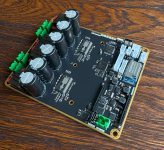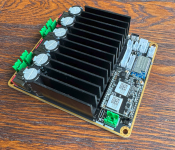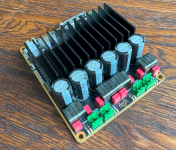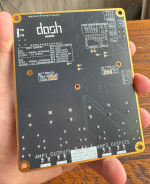Great project. I was searching the web for TAS3251 hoping someone had a board design. My interest is for building a pair of 2-way powered speakers using DSP for the crossovers.
Last edited:
Hello everyone! Here are some updates (and photos) on this project!
This is currently fourth revision of the 4x175W digital amplifier board with ADAU1452 DSP. This is the first version that’s actually going to be released.
Right now, we are fine-tuning some details in SW but we already have a few first customers waiting for delivery.
The board has gone through many changes and optimizations over the past year. As for THD+N, we’re at around 0.005% up to 50W, and even at 100W we’re still slightly below 0.01% – all measured using a QA403 analyzer.
On the digital input side, we support USB, I2S, SPDIF, Bluetooth – basically all codecs – and WiFi, with streaming support for Spotify, Tidal, and many others. For BT and WiFi, we can even read track metadata (title, length, encoding, bitrate, etc.).
All features of the ADAU1452 DSP can be used, with all inputs and outputs routed into it. I won’t go into too much detail, but the entire DSP setup can be created in Analog Devices’ SigmaStudio, which offers a lot of features (I'm just recapitulating but this was discussed in previous posts already).
The entire amplifier is fully controllable via UART/SCPI interface, including system diagnostics and control over individual DSP blocks.
Multiple amplifier modules can be daisy-chained, both wired and wirelessly, making it possible to create multiroom or wireless stereo setups.
The module includes inrush current and reverse polarity protection. It can be powered via USB-C up to 120W, though it's primarily intended to be powered via a DC connector up to full power. Both power options can be connected at the same time, and the board will automatically choose the one that is more appropriate.
The entire module is passively cooled and fairly compact at 105 x 130 mm.
The module is now hardware-ready, and future improvements will come via firmware updates. For example, USB currently supports 48kHz/16bit, but we plan to support 192kHz/24bit down the line.
We also plan to offer two more variants of the module – same functionality, just different power stages (lower and higher power output). Additionally, we’ll be offering a control module with analog input/output, a range of buttons, encoders, and a display – all fully configurable by the user.
This is currently fourth revision of the 4x175W digital amplifier board with ADAU1452 DSP. This is the first version that’s actually going to be released.
Right now, we are fine-tuning some details in SW but we already have a few first customers waiting for delivery.
The board has gone through many changes and optimizations over the past year. As for THD+N, we’re at around 0.005% up to 50W, and even at 100W we’re still slightly below 0.01% – all measured using a QA403 analyzer.
On the digital input side, we support USB, I2S, SPDIF, Bluetooth – basically all codecs – and WiFi, with streaming support for Spotify, Tidal, and many others. For BT and WiFi, we can even read track metadata (title, length, encoding, bitrate, etc.).
All features of the ADAU1452 DSP can be used, with all inputs and outputs routed into it. I won’t go into too much detail, but the entire DSP setup can be created in Analog Devices’ SigmaStudio, which offers a lot of features (I'm just recapitulating but this was discussed in previous posts already).
The entire amplifier is fully controllable via UART/SCPI interface, including system diagnostics and control over individual DSP blocks.
Multiple amplifier modules can be daisy-chained, both wired and wirelessly, making it possible to create multiroom or wireless stereo setups.
The module includes inrush current and reverse polarity protection. It can be powered via USB-C up to 120W, though it's primarily intended to be powered via a DC connector up to full power. Both power options can be connected at the same time, and the board will automatically choose the one that is more appropriate.
The entire module is passively cooled and fairly compact at 105 x 130 mm.
The module is now hardware-ready, and future improvements will come via firmware updates. For example, USB currently supports 48kHz/16bit, but we plan to support 192kHz/24bit down the line.
We also plan to offer two more variants of the module – same functionality, just different power stages (lower and higher power output). Additionally, we’ll be offering a control module with analog input/output, a range of buttons, encoders, and a display – all fully configurable by the user.



